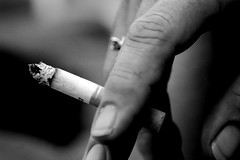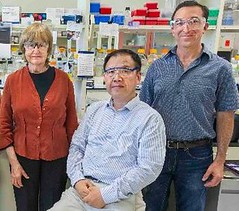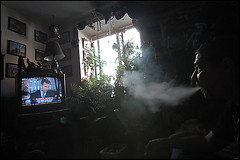 科學界首次發現三手菸(即二手菸在物體表面留下的有毒殘餘物)會透過呼吸、攝食或肌膚接觸等途徑進入人體內,對人體細胞造成基因上的損害。
科學界首次發現三手菸(即二手菸在物體表面留下的有毒殘餘物)會透過呼吸、攝食或肌膚接觸等途徑進入人體內,對人體細胞造成基因上的損害。
美國柏克萊實驗室科學家、研究共同者Lara Gundel說,「這是第一個發現三手菸為突變因子的研究。」他補充,「三手菸含有菸草特有的亞硝胺,是毒性最強的致癌物之一,會殘留在物體表面。若是殘留在衣服或地毯上,對孩童的威脅尤其嚴重。」
此研究執行單位是勞倫斯柏克萊國家實驗室(Lawrence Berkeley National Laboratory,簡稱柏克萊實驗室)。研究也發現,慢性、長時間的暴露比急性、歷時一天以內的暴露危害更大。
研究指出,三手菸殘留時間越久殺傷力越強。科學家發現,暴露於慢性三手菸的樣本,化學物質的濃度比急性三手菸的樣本高,造成DNA損害的程度也比暴露於急性三手菸的樣本更大──此研究〈三手菸造成人類細胞DNA損害〉發表於當期《突變》(Mutagenesis)期刊。
研究人員用兩種常見的體外實驗方法檢驗樣本的基因毒性,發現三手菸能造成DNA股斷裂,以及可能引起基因突變之氧化性DNA損傷(oxidative DNA damage)。
基因毒性和疾病的發展有關,也是抽菸和二手菸導致癌症的關鍵機制。
三手菸因為難以被完全清除,其危害不易察覺。有研究發現,抽菸者搬走兩個月後,其公寓內的物體表面和灰塵中都還能偵測到三手菸。
一般的清潔方式如吸塵器、擦拭和通風,都尚未證實能夠有效降低尼古丁污染。
 「你可以減少氣味分子,但是很難完全清除三手菸。最好的方法是把物品換掉,如換地毯、重新油漆。」柏克萊實驗室環境能源科技部門化學家Hugo Destaillats說。
「你可以減少氣味分子,但是很難完全清除三手菸。最好的方法是把物品換掉,如換地毯、重新油漆。」柏克萊實驗室環境能源科技部門化學家Hugo Destaillats說。
研究也指出三手菸的殺傷力會隨著時間變得越來越強。
研究者把一條一條的紙張放進吸菸箱內以製作樣本。急性樣本由柏克萊實驗室製作,暴露於5根香菸,歷時約20分鐘;慢性樣本則由加州大學舊金山分校製作,歷時196天,共暴露於香菸258小時,這段時間內,吸菸箱有通風時間35小時。
研究者發現,他們所檢測的化學混合物中,有超過半數在慢性樣本上的濃度比急性樣本高。研究者也觀察到,慢性樣本造成的DNA損害程度較高。
柏克萊實驗室2010年的研究發現,殘留尼古丁會和室內空氣常有的污染分子臭氧及亞硝酸產生化學反應,形成有害物質。
 當三手菸中的尼古丁和亞硝酸發生化學反應,形成致癌的菸草特有亞硝胺(tobacco-specific nitrosamines)。
當三手菸中的尼古丁和亞硝酸發生化學反應,形成致癌的菸草特有亞硝胺(tobacco-specific nitrosamines)。
尼古丁能和臭氧反應形成極小的粒子,運載有害化學物質進入人體組織。
研究中,Hang和研究者們用培養基將紙張上的混合物擷取下來,並用此培養基培養人體細胞24小時,接著測量混合物的濃度。
科學家們下結論,「最終,關於三手菸如何增加疾病發生機率的新知識,應啟發新的預防對策。」
For the first time, scientists have documented that thirdhand smoke – the noxious residue that clings to virtually all surfaces long after the secondhand smoke from a cigarette has cleared out – causes genetic damage in human cells.
Humans can be exposed to thirdhand smoke through inhalation, ingestion or skin contact.
"This is the very first study to find that thirdhand smoke is mutagenic," said Lara Gundel, a Berkeley Lab scientist and co-author of the study.
"Tobacco-specific nitrosamines, some of the chemical compounds in thirdhand smoke, are among the most potent carcinogens there are," said Gundel. "They stay on surfaces, and when those surfaces are clothing or carpets, the danger to children is especially serious."
The study led by researchers from Lawrence Berkeley National Laboratory also found that chronic exposure over time is worse than acute exposure, a single exposure lasting less than a day.
Suggesting that the smoke residue becomes more harmful over time, the scientists found that the chemicals in samples exposed to chronic thirdhand smoke existed in higher concentrations and caused more DNA damage than samples exposed to acute thirdhand smoke,
Their paper, "Thirdhand smoke causes DNA damage in human cells," is published in the current issue of the journal "Mutagenesis."
The researchers used two common in vitro tests to examine the samples for genotoxicity. They found that thirdhand smoke can cause both DNA strand breaks and oxidative DNA damage, which can lead to gene mutation.
Genotoxicity is associated with the development of diseases and is a critical mechanism responsible for many types of cancer caused by smoking and secondhand smoke exposure.
Thirdhand smoke is particularly insidious because it is extremely difficult to eradicate. Studies have found that it can still be detected in dust and surfaces of apartments more than two months after smokers moved out.
Common cleaning methods such as vacuuming, wiping and ventilation have not proven to be effective in lowering nicotine contamination.
"You can do some things to reduce the odors, but it's very difficult to really clean it completely," said Hugo Destaillats, a chemist from Berkeley Lab's Environmental Energy Technologies Division who participated in this study. "The best solution is to substitute materials, such as change the carpet, repaint."
The new study suggests thirdhand smoke could become more and more harmful over time.
To generate the samples, the researchers put paper strips in smoking chambers. The acute samples, generated at Berkeley Lab, were exposed to five cigarettes smoked in about 20 minutes.
The chronic samples, generated at the University of California, San Francisco, were exposed to cigarette smoke for 258 hours over 196 days. During that time, the chamber was also ventilated for about 35 hours.
The researchers found that the concentrations of more than half of the compounds studied were higher in the chronic samples than in the acute samples. They also found higher levels of DNA damage caused by the chronic samples.
Studies from Berkeley Lab conducted in 2010 found that residual nicotine can react with ozone and nitrous acid, both common indoor air pollutants, to form hazardous agents.
When nicotine in thirdhand smoke reacts with nitrous acid it undergoes a chemical transformation and forms carcinogenic tobacco-specific nitrosamines.
Nicotine can react with ozone to form ultrafine particles, which can carry harmful chemicals and pass through human tissue.
During the study, Hang and his coworkers exposed the human cells by first extracting the compounds from the paper with a culture medium then using the medium to culture the human cells for 24 hours. The concentrations of the compounds were then measured.
The researchers conclude, "Ultimately, knowledge of the mechanisms by which thirdhand smoke exposure increases the chance of disease development in exposed individuals should lead to new strategies for prevention."
※ 全文及圖片詳見:ENS

